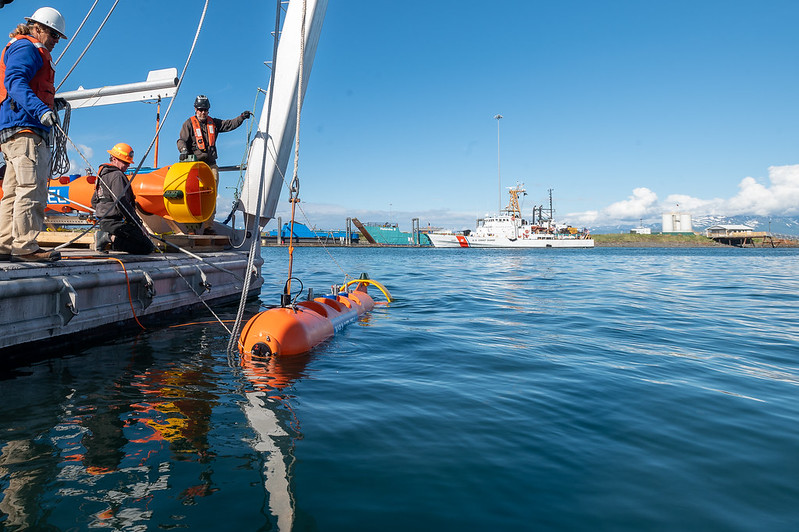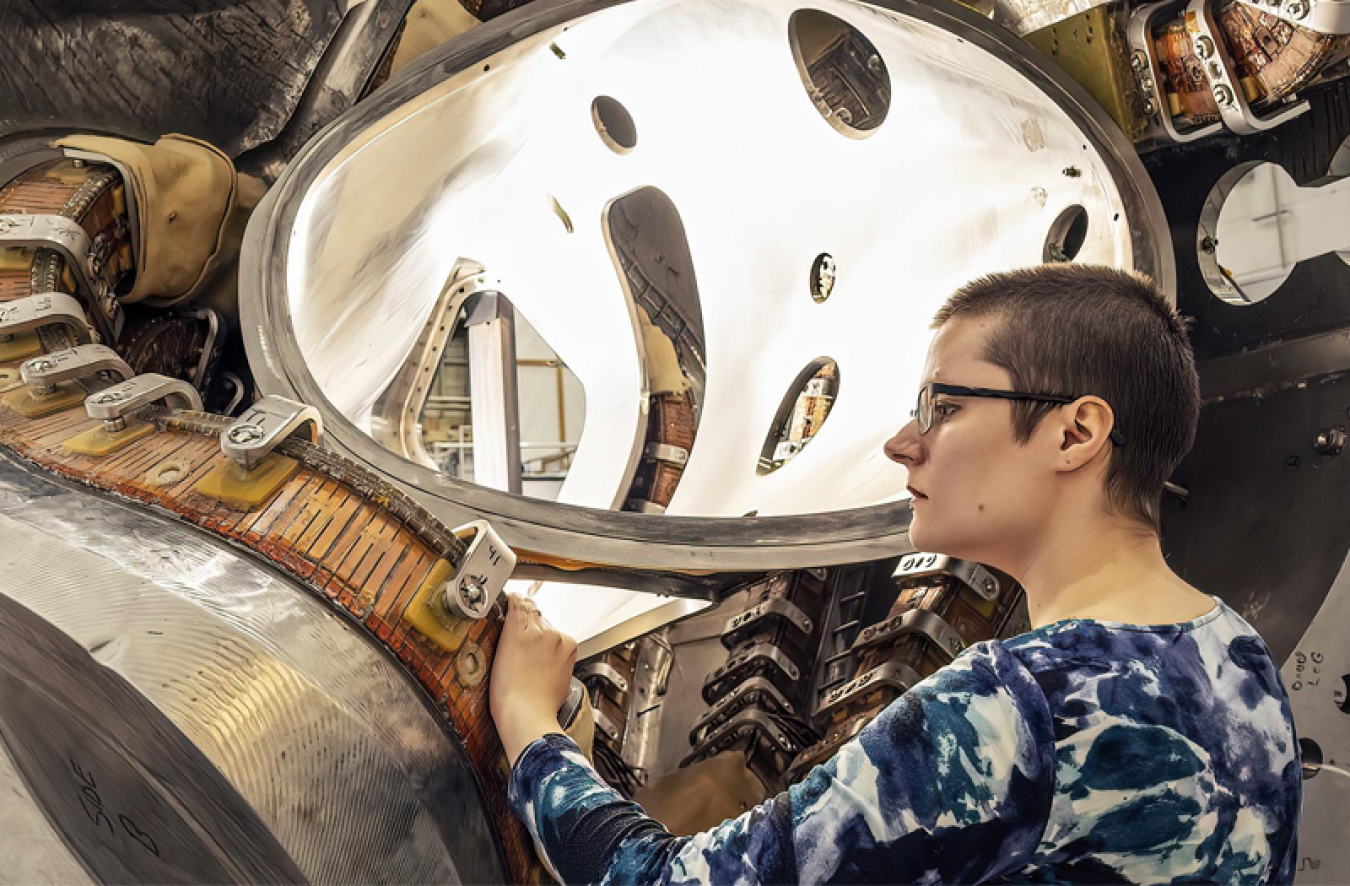We're Leading Fusion Research
Fusion occurs when two light atoms like hydrogen combine to form a heavier atom like helium. This process occurs in our Sun and other stars. To create and sustain fusion on Earth, scientists use devices that generate and sustain plasmas. Plasmas are “ionized” gases that are so hot that electrons are freed from atomic nuclei. In many fusion approaches, researchers use electric and magnetic fields to control the resulting collection of ions and electrons. At sufficiently high temperatures, ions fuse together. This process—fusion—releases energy in the form of heat. Scientists are working hard to recreate the process here on Earth and to collect the energy to make electricity or for other energy-intensive applications.
The Department of Energy (DOE) has been investing in fusion research for decades. U.S. government support for fusion energy research and development began in the 1950s at the Atomic Energy Commission, the predecessor to DOE. In recent decades, it has continued through the Office of Science (SC) Fusion Energy Sciences (FES) program to establish the scientific foundations for a fusion energy source. These efforts include support of international collaborations like ITER. DOE’s National Nuclear Security Administration supports the Inertial Confinement Fusion (ICF) program to advance its Stockpile Stewardship mission. Starting in 2015, ARPA-E has supported areas of potentially transformative fusion R&D with a focus on enabling timely fusion commercialization.
Commercial fusion energy has the potential to revolutionize the energy industry, help achieve energy abundance and security, and help meet the growing clean energy needs of the United States and the world. Fusion may also potentially provide a combined source of energy in the form of heat and power for hydrogen production, industrial heat, carbon capture, and desalination.
At the same time, fusion has both technology gaps (e.g., materials and fuel cycle) and potential risks that need to be managed. These risks include the generation of activated waste in structural materials that will require short-term storage and recycling solutions. Fusion may also create potential proliferation pathways. DOE stands ready to deliver innovations that not only bring fusion to technical and commercial viability but also help manage these risks.
Highlights
-
DOE Fusion Energy Strategy 2024, Executive SummaryNovember 23, 2024
-
The new FES vision focuses on aggressively closing the science and technology gaps needed to realize commercial fusion energy. The three key elements of the vision are: workforce development, bridging gaps and transformational science.
-

Areas of Fusion Research
The DOE fusion energy program helps researchers coordinate across the many fundamental scientific and technical disciplines that are involved with fusion, including plasma physics, materials science and engineering, and advanced scientific computing. Scientists can create conditions for fusion with techniques that use a variety of magnetic, electrical, and other methods to shape and control plasma.
Magnetic confinement research facilities at national laboratories and universities have helped researchers better understand how to generate and sustain fusion reactions and eventually generate power from them. This progress motivated the international collaboration on the ITER experiment. ITER aims to build and operate a burning plasma experiment based on a magnetic confinement concept called a tokamak. (Many tokamaks currently exist, including DOE Office of Science user facilities like the DIII-D National Fusion Facility, but ITER will be the largest one.) DOE is a major supporter of ITER. Once built, ITER will be the world’s largest international scientific research facility.
In inertial confinement fusion experiments, the fusion device compresses and heats a target to initiate fusion. The biggest of these devices is the National Ignition Facility (NIF) at DOE’s Lawrence Livermore National Laboratory. The laboratory supports the National Nuclear Security Administration, which is responsible for our nation’s nuclear security.
The NIF fires 192 laser beams into a hollow cylinder that has a tiny capsule in it. This creates a “bath” of X-rays that blow off the surface of the capsule, which is filled with partially frozen hydrogen isotopes. The result is a rocket-like implosion. It compresses and heats the isotopes to conditions of pressure and temperature found only in the cores of stars and giant planets as well as exploding nuclear weapons. The speed of the implosion allows the fusion reactions to take place before the fuel can disassemble. In 2022, the lab achieved ignition—producing more fusion energy than the amount of laser energy delivered to the NIF target.
This breakthrough, decades in the making, was pivotal for NNSA’s Stockpile Stewardship Program, which aims to ensure the safety and reliability of the U.S. nuclear arsenal without nuclear explosive testing. Since the first successful attempt, NIF has achieved fusion ignition multiple times, further validating the breakthrough. NIF’s recreation of extreme environments allows scientists to study the behavior of materials under weapons-relevant conditions that were previously impossible to achieve in a laboratory setting. The 2022 achievement is not only vital for maintaining the effectiveness and safety of the U.S. nuclear arsenal but is also a stepping-stone for the future of fusion energy.
Other relevant research areas include the study of materials for future devices, integrated systems for generating electricity from fusion, and breeding fuel for the fusion process.
Fusion Forward: Into the Bold Decadal Vision
Over the past decade, the landscape around fusion energy research and development (R&D) has evolved significantly, especially in the United States. Building on decades of public investments in fusion science and technology, major advances such as the achievement of fusion ignition are being achieved domestically and globally by public and private sector entities. These are indications of fusion’s increasing technical readiness. Other major scientific advances, e.g. in high-temperature superconductors, advanced materials, and artificial intelligence, have the potential to further accelerate and transform fusion R&D.
Press Releases
From Our Blogs
-
- Fusion
- Clean Energy
- Nuclear Energy
- Next-Generation Energy Technologies
- Research, Technology, and Economic Security
October 9, 2024 -
- Particle/High Energy Physics
- Fusion
- Next-Generation Energy Technologies
- Nuclear Energy
- Research, Technology, and Economic Security
September 19, 2024 -
- Clean Energy
- Next-Generation Energy Technologies
- Research, Technology, and Economic Security
- Fusion
- Particle/High Energy Physics
September 18, 2024


